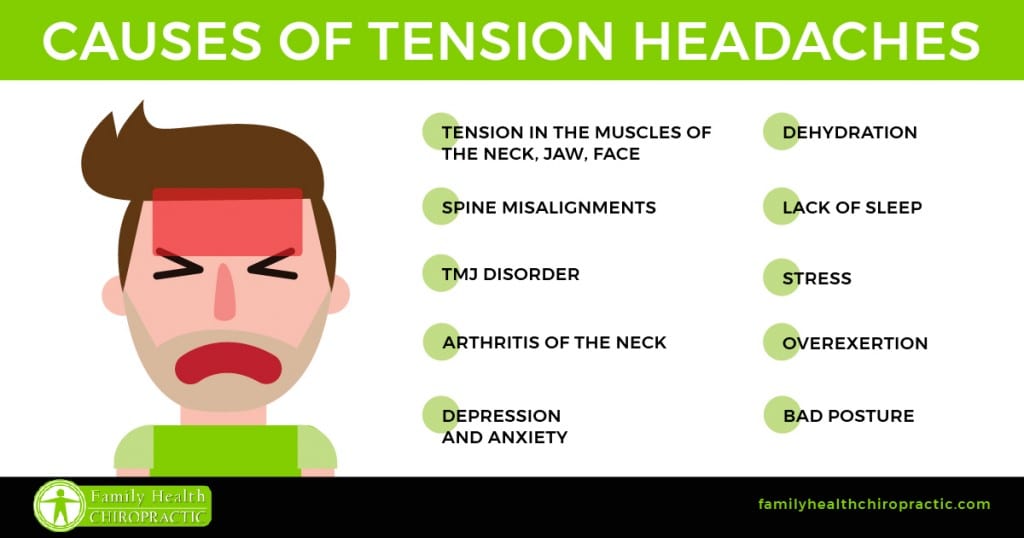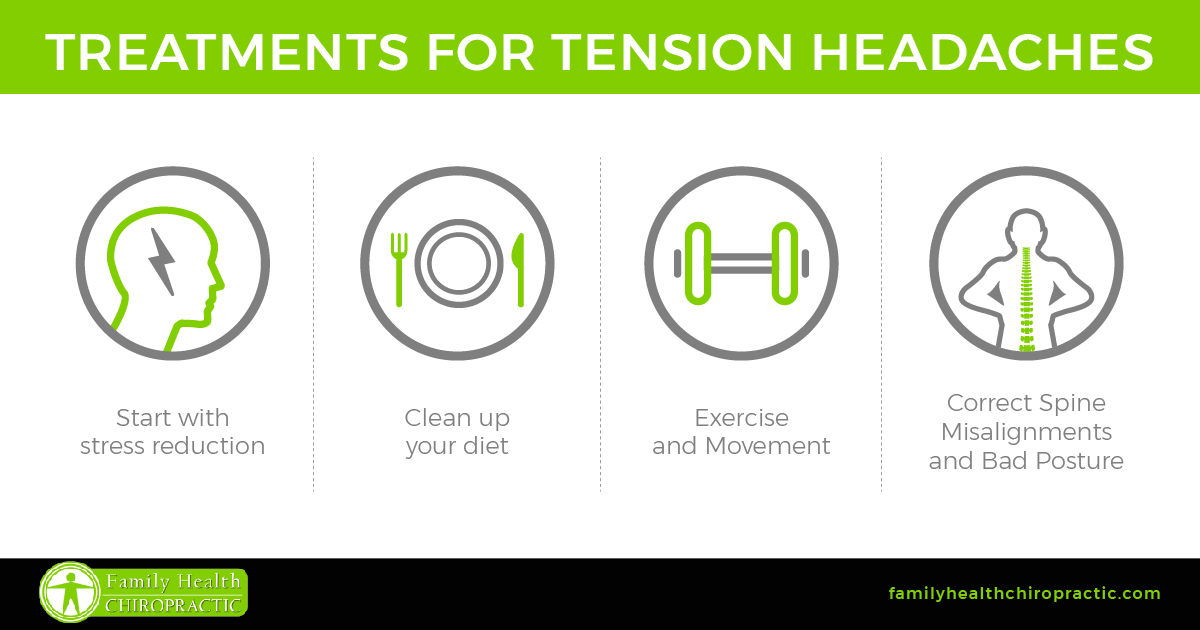The “Everyday” Headache, also known as tension headaches occur when there is uncomfortable tightness or pressure around the entire head. It's estimated that up to 80 percent of the adult U.S. population suffers from at least occasional tension headaches, with around 3 percent experiencing chronic daily tension headaches.
This should be no surprise given the relationships between poor posture, stress and anxiety and the development of tension headaches.
Tension headaches, sometimes referred to as stress-headaches, is the most common type of headache.
| Tension Headache | Migraine |
|---|---|
| musculoskeletal pain | neurological “brain ache” |
| mostly less awful | often worse…but not always! |
| usually both sides | usually one side |
| pressure, tightness | throbbing, pulsating |
| noise sensitivity | light sensitivity |
| few weird symptoms | weirdness is more standard |
Common Causes of Tension Headaches
Its name should indicate the role that stress and mental or emotional conflict can have in triggering not only pain, but contraction of the muscles in the neck, face, scalp, and jaw during a tension headache.
Most tension headaches are assumed to be a muscle-joint-bone problem — so bones, joints, and your meat :) — as opposed to the neurological “brain ache” of migraine headaches.
For instance, a headache caused by tension could be cervico-genic (“from the neck”) — but it’s controversial, yet no one really knows for sure.
Depression and anxiety can cause tension headaches as well.
Other causes include physical postures (forward head posture, slumped or rolled shoulders) and misalignments of the spine that strain head and neck muscles (such as holding your chin down while reading or holding a phone between your shoulder and ear), degenerative arthritis of the neck, and temporomandibular joint dysfunction (a disorder of the joints between the temporal bone located above the ear and the mandible, or lower jaw bone).
Tension Headache Symptoms
Symptoms of tension headaches can include:
- Mild to moderate pain to the front of the face, head or neck
- Dull, aching head pain (it can be felt as if there’s a tight strap around the head)
- Lots of pressure and tightness across the forehead (usually both sides of the head)
- Muscles aches or pains on the sides and back of your head, including running down your neck
- Sensitivity to loud noises
- Tenderness when you touch your hair line, scalp, neck and shoulders
There is more than one type of tension headache, so doctors usually split tension headaches into two main divided categories that describe how often they occur: either episodic headaches (which happen now and then) or chronic headaches (which are experienced much more often).
Episodic tension headaches tend to occur fewer than 15 days of the month (for example, every other day or a few times per week), while in contrast, chronic tension headaches can happen much more often — for some people even nearly every day. Episodic headaches usually last for about 30 minutes to a few hours, but at times they can linger for as long as one week.
Chronic tension headaches usually last at least several hours and are more likely to be continuous, causing nagging pain that won’t seem to quit. Doctors consider someone to suffer from chronic headaches if more days than not he or she deals with head pain. It’s also possible to start off having only episodic tension headaches now and then, but soon notice that they become more frequent and chronic in nature.
Treating Tension Headaches
The first step in caring for a tension headache involves treating whatever disorder or disease is causing it.
For example, if you have a misalignment in your spine that is causing arthritis of the neck, this arthritis could also be the cause of a tension headache. So treating neck arthritis would be a good start. If someone has TMJ problems and this is causing tightness in the neck and jaw muscles, then correcting the TMJ disorder would be the first step.
The reality is, treating your tension headaches is going to require a combination of lifestyle changes, improving certain health habits and letting go of things that don't help (anger, stress, poor diet, etc).
Start With Managing Your Stress
The first strategy to correcting tension headaches is to work on stress.
Stress increases stress hormones, such as cortisol, which can in turn make you more prone to pain and discomfort. Cortisol also causes constriction of your blood vessels, which then decreases blood flow and can cause tightness in your muscles.
Because stress is the primary trigger for tension headaches — which is why a tension headache is also known as a stress headache — most people need to find various ways to lower the impact of stress on their lives in order for their headache symptoms to improve.
A few things that you can try include:
- Try reading something inspiring
- Use soothing essential oils for headaches
- Perform deep breathing exercises
- Meditate or Pray
- Spend more time outdoors
Clean Up Your Diet
Another important factor in treating tension headaches is your diet.
Make sure you are eating plenty of anti-inflammatory foods that support energy levels and ability to cope with stress.
This also means that you should avoid those things that don't support energy such as sugar, caffeine and processed foods.
Things to consider when eating healthy for tension headaches:
- staying hydrated and drinking enough water
- skipping sugary snacks that lead to blood sugar fluctuations
- avoiding smoking or drinking too much alcohol
- limiting the amount of caffeine you drink and not drinking caffeine too close to bedtime
- eating every few hours to keep blood sugar levels stable,
Some of the best foods for preventing headaches include:
- clean sources protein to stabilize blood sugar — cage-free eggs, wild fish, grass-fed meat or raw dairy (choose unprocessed meat that’s preferably organic to avoid additives that can trigger allergies or headaches)
- foods high in fiber — vegetables, fruits, ancient grains, nuts and seeds all contribute fiber to your diet, which reduces constipation that’s linked to headaches
- healthy fats to reduce inflammation and prevent blood sugar dips — nuts, seeds, coconut oil or olive oil, avocado, and wild-caught fish help you digest important nutrients and are important for brain function and hormonal balance
- foods high in magnesium and electrolytes — green leafy vegetables, sweet potatoes, melon and bananas are some good sources of magnesium, which relaxes muscles
Some of the worst foods for tension headaches:
- too much sugar — can cause hormonal changes
- common food allergies — gluten, cows dairy, peanuts, eggs, soy and shellfish can trigger constipation, muscle stiffness and headaches
- alcohol — causes changes to blood flow in the brain and dehydration
- salty foods — too much sodium, especially from packaged, processed foods or restaurant meals that have added MSG and other chemicals
Exercise And Movement for Tension Headaches
Regularly getting exercise is great for lowering stress, plus it has positive effects on blood pressure levels, sleep and your overall health.
People who exercise more are less likely to deal with stressful diseases (like heart problems or diabetes), obesity and depression. Physical activity also improves circulation and can help build strength in muscles that support good posture.
Studies find that moderate exercise can reduce the frequency and severity of strong headaches, even migraine attacks, in some people — especially when coupled with other healthy habits like a nutrient-dense diet and getting good sleep.
Exercise benefits your mood by changing levels of the body’s natural “feel good” chemicals called endorphins, which are natural pain killers and antidepressants.
Correct Spine Misalignments and Poor Posture
Staring into a screen all day can contribute to headaches because of increased stress and the effects of blue light omitted from electronic devices — but don’t forget that your spine and posture is also very important.
Poor posture can cause shoulder and neck muscles to become tense, pinching nerves that lead to headache pain. This is especially true if you’ve dealt with injuries in the past that have affected muscles along your spine, shoulders or neck.
How can you improve your posture?
- Work on improving your posture both when sitting or standing.
- Hold your shoulders back and your head level, parallel to the ground, instead of hunching forward.
- If you’re sitting for long hours at a desk, use a supportive chair that helps your muscles relax naturally, keep a computer screen at eye level (so your neck doesn’t become tight)
- Pull in your core/abdomen to keep you sitting upright.
The most supportive types of desk chairs help keep your spine long, back upright so your head isn’t slumping forward and your thighs parallel to the ground.
Chiropractic adjustments can correct spine misalignments. The first step is to undergo an examination by a qualified healthcare professional. A solid examination would include a posture analysis, movement examination and XRays of the neck.





